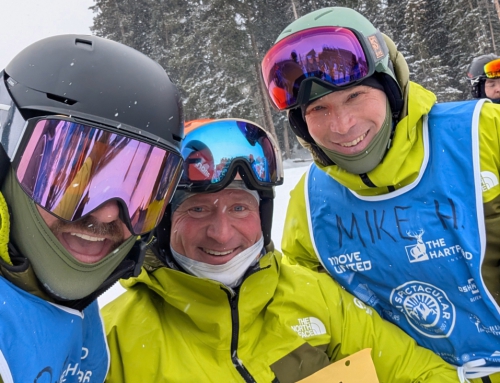32 Degrees: Safety on the Slopes
With U.S. skier visits cresting 60 million for the past several seasons, staying safe is top of mind for snow pros, especially as they prepare for the busy holiday season. This excerpted article, written by Krista Crabtree, a Level II alpine instructor, with a Children’s Specialist 2 credential, appears in the Fall 2024 issue of 32 Degrees. You can read the entire article here.
***
Andy Gould, a longtime Vail Ski and Snowboard School instructor who began teaching at Beaver Creek in 1983, estimates he’s spent nearly 5,000 days in uniform. “Instructors are a pretty good barometer for what’s happening on the hill,” he says. What’s going on, from his perspective and other snow pros across the country, is a pressure cooker of unsafe skier and rider behavior combined with record numbers of skier visits.
“I’m seeing more aggression on the hill, excessive speed, and people skiing or riding above their ability level,” says Gould. “We ingrain the responsibility code into our students at an early age, but many people don’t have that education and they don’t realize that there could be dire consequences for their speed and actions.”
A PLAN TO MAKE HILLS SAFER
The behavioral changes that Gould has witnessed over the past few seasons compelled him to join safety committee meetings with other Vail instructors and supervisors. The intention of the meetings included strategizing ways to make the hill safer for employees and the public. “The goal is to have a positive interaction with the public and also not take away from our guests’ experience by being in a confrontation,” says Gould.
Last season, Gould needed to put that plan into action when his client was clipped from behind by an individual who came out of the trees onto a cat track. “I asked him to stop, he said, blank-you, and skied off. My client was OK, so we skied down and saw the guy in the liftline. I called patrol from the lift, gave a description, the chair number, and at the top, four patrollers were waiting. The guy escalated the situation with patrol. They warned him several times about suspension, but he kept escalating, and consequently lost the privilege to ski there. It was a coordinated effort between ski school and patrol.”
Snow pros and ski patrollers have a front row seat to the public’s behavior on the slopes, and many can tell an immediate story about an incident they witnessed that had to do with inappropriate or risky behavior. These frontline workers aren’t the only ones talking about these safety issues.
According to Kelly Pawlak, former president and CEO of the National Ski Areas Association (NSAA), ski area operators are having in-depth discussions about this topic as well. “Many [resorts] are ramping up guest safety education including information on their websites, social media, and trail guides,” says Pawlak. “Much of the safety content is video and there have been some very compelling and creative approaches.”
NSAA has launched a guest-facing website – skisafety.us – inspired by safety.skicalifornia.org and skisafety.ca, which promotes safety and risk awareness. “Safety is a culture,” says Pawlak. “Part of the work of the ski area is to influence human behavior. Large companies have extensive sites, but most resorts are small and have limited resources so we launched a national resource that guests can go to.”
PC: Jackson Hole Mountain Resort







